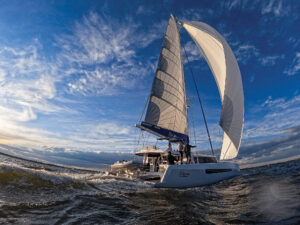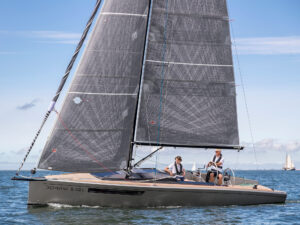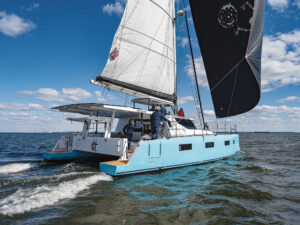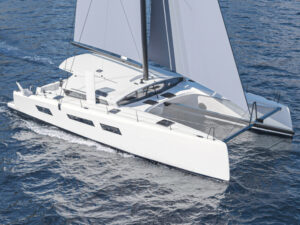
Island Packet Yachts turns 30 this year and has marked the occasion, in part, with the launch of its new Estero. This 36-foot sloop borrows heavily from the rock-solid cruising boats that have come before it, but also surprises with new design features and hints of Island Packets to come.
Lined up along the dock with its range of siblings at the Strictly Sail Pacific boat show in Oakland, California, the Estero fit right in with its ivory-colored cousins, thanks to its extended bow sprit with integrated anchor roller, bob stay on the bow, Hoyt Jib Boom on the foredeck, solid bulwarks from stem to stern, long coachroof ending in sweeping coamings aft, and the optional stern swim platform.
It was after stepping aboard and below this latest creation of company founder and chief designer Bob Johnson that I realized he had something clearly different in mind when he set pencil to paper this time around. For the Estero, he threw the traditional layout concept of V-berth/saloon/aft cabins out the porthole and instead created a wide-open interior centered around a saloon that extends forward all the way to the watertight bulkhead that separates the interior from the anchor locker. V-shaped berth-length settees extend aft, enveloping a drop-leaf table to create a large sitting area or, with the table dropped down and the optional filler cushions in place, a large area where, say, your kids or the grandkids could romp when off on a daysail or weekend cruise.
A roomy head with an adjoining shower sits unobtrusively amidships to starboard; to port is a U-shaped galley with double sinks, a side-by-side fridge and freezer, and a two-burner propane stove and oven. Here, the cook can be part of the party while enjoying lots of counter space to whip up a meal. There is, of course, ample storage in the outboard and under-counter cabinets and drawers, should a longer passage be part of the plans.
To port of the companionway, the owner’s generously sized stateroom looks inviting with its innerspring double mattress, hanging locker, and shelves for storage. I found that there was plenty of room to move about, and I was intrigued by the engine access door, on which was mounted the fuel filter so it could be easily reached and changed. Other engine access is available through a lift-off cover in the owner’s cabin and via a panel behind the companionway ladder.

The cabin I found most interesting was to starboard of the companionway, described by Bill Bolin, I.P.’s vice president of sales and marketing, as a “lusty double, ” meaning that there’s enough room there that a young romantic couple might find it quite cozy when the accordion-style folding door is pulled closed. The door itself struck me as something that could show wear far earlier than the rest of the interior, but that’s a minor criticism, and I’m not sure how else the space could be closed off, save for a curtain. With the door open, the cabin is light and airy, and the bunk would make a fine sea berth or when not needed for crew, a storage area for bags and gear. The head of the berth doubles as a seat for the fold-down nav station desktop and foldout chart locker behind it.
The Estero’s interior woodwork is African mahogany. The first three boats, including the one I sailed, were built with a teak and oak sole in the forward part of the saloon; subsequent ones have a mahogany and oak sole in that area. The sole from the galley back is textured fiberglass and includes a grated sump at the foot of the companionway. There’s carpeting in the owner’s cabin. All tanks-120 gallons for water, 60 for fuel, and 35 for holding-are beneath the floor to keep weight low, where it belongs.
The Estero’s moderate-displacement hull is molded using IP’s proprietary PolyClad3 system, which utilizes a vinyl-ester skin coat and the company’s specialized application equipment to ward off osmotic blisters; the hull carries a 10-year warranty. Its design, like all I.P.s, includes Johnson’s Full Foil Keel, which allows for a moderate draft of 4 feet, while providing good upwind performance. Within the keel sits 7,500 pounds of lead, with another layer of glass above it, effectively giving the Estero a double bottom. The shoebox-style hull/deck joint extends down over the side and is screwed and glued in place. On deck, long benches line the cockpit on either side of a single wheel and pedestal; the seats are designed to take a crowd daysailing and would make a good place for the off watch to stretch out and nap.
I.P.’s enjoys a legion of loyal owners, and with the Estero, Johnson has executed a design for those who want sailing to be simple and easy on the crew. The self-tending rig consists of an in-mast furling main with vertical battens and a self-tending jib set on a Harken roller furler. Setting sail is as easy as pulling a couple of lines. Closehauled, tacking involves turning the Edson wheel, and the rack-and-pinion steering does the rest. On the new tack, there’s no need to touch the sheets. Off the wind, the jib boom keeps the headsail working efficiently.
Though our test sail was on San Francisco Bay, someone forgot to tell the wind gods we were there. We motored out of the marina in Oakland, pushed along easily through glassy seas at about 7 knots by the 40-horsepower Yanmar engine with a conventional shaft and propeller. Our departure from the marina’s tight quarters was made simple, thanks to the optional Vetus 6-horsepower bow thruster. Out on the bay, the wind was light at best. Still, in about 5 knots of breeze we approached speeds of 3 or so knots over the ground, and the boat tacked in these conditions through about 80 degrees. I wished I could’ve been aboard later in the day when we watched from afar as the boat heeled smartly and appeared to be reveling in a breeze in the low teens.
In recent conversations (see “The Man in the Ivory Boat,” October 2009), Bob Johnson has said that his vision of the boat of the future is one that takes advantage of the latest technology to make sailing as simple and pleasurable as possible. In that regard, the new Estero is a step ahead.
Mark Pillsbury is the editor of CW.
Specs
LOA (w/ swim platform) 38′ 5″ (11.71 m.)
LWL 31′ 5″ (9.58 m.)
Beam 12′ 4″ (3.76 m.)
Draft 4′ 0″ (1.22 m.)
Sail Area (100%) 708 sq. ft. (65.8 sq. m.)
Ballast 7,500 lb. (3,410 kg.)
Displacement 18,800 lb. (8,545 kg.)
Ballast/D .40
D/L 270
SA/D 16.0
Water 120 gal. (454 l.)
Fuel 60 gal. (227 l.)
Mast Height 54′ 0″ (16.46 m.)
Engine 40-hp. Yanmar
Designer Bob Johnson
Price $350,000
Island Packet Yachts
(727) 535-6431
www.ipy.com








